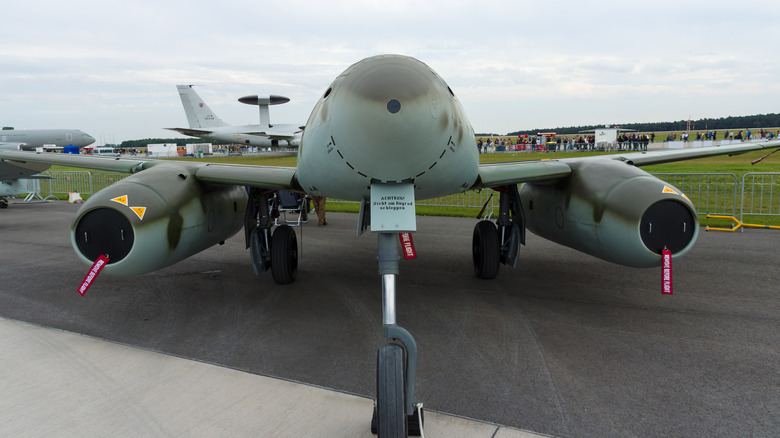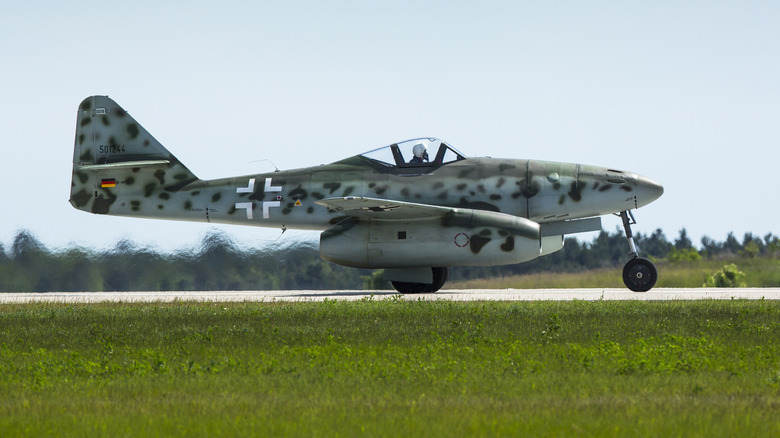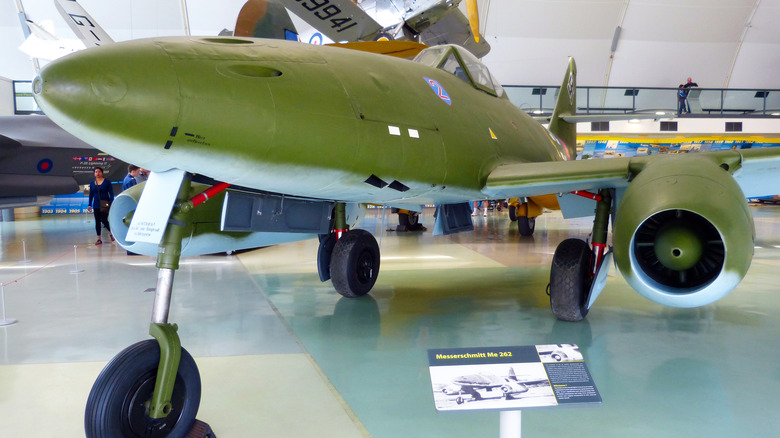The Incredible Capabilities Of The World's First Combat Jet Fighter
For as long as aviation technology has allowed, some of warfare's most decisive battles have been fought (at least partially) in the air. World War II's Battle of Britain, for instance, which raged from July to October 1940, could have changed the entire outcome of the war. Had the Luftwaffe triumphed over the Royal Air Force in this aerial conflict, the way would have been clear for Germany's proposed invasion of Britain, Operation Sea Lion. From there, the Axis advance may have been unstoppable.
Aerial supremacy in combat is a crucial consideration. Without it, land and sea forces alike are in far greater danger of being harried, progress can be stalled entirely, and the whole theater of war looks completely different. As a result, then, it's little wonder that so much time, money, and other resources are spent on developing military aircraft.
The fearsome firepower of the Luftwaffe during World War II cannot be overstated. The infamous Blitz of Britain, according to the Imperial War Museum, resulted in more than 43,500 civilian deaths in less than 10 months. One of the most formidable tools the German air force had in its arsenal during this period was the Me 262, the first fighter jet ever created.
The potential of the fearsome Me 262
According to the Collings Foundation, the Me 262 did not begin its life as a jet at all. For its creators, Messerschmitt, its initial development was similar to that of any other aircraft. The P.1065, as it was known at the beginning of the process in 1939, went through technical issues that will be infinitely familiar to anyone developing ... absolutely anything today. Jet tech is especially volatile; remember Jay Leno's jet car?
It was intended to be jet-propelled, but this only became possible several years later. During early testing, the Foundation explains, Junkers Jumo 210 engines powered it, as they had Messerschmidt models that preceded it: the Me 109 and Me 110. The aircraft's development was hindered by a lack of resources, as the German command seemed to consider expensive jet technology unnecessary to prevail. Early Axis successes may very well have reinforced this view; 1942 and 1943 saw test flights, tweaks to the system, and scrambles for increasingly scarce materials that could be used in production, but the following year it finally joined the ranks of the Luftwaffe as a true jet fighter.
The revolutionary aircraft was equipped with frightful weapons, including a quartet of 30mm Mk108 cannons and mighty 250 kg bombs. Able to fly at up to 540 mph (around 869 kph), it was both speedy and formidable, a devastating opponent for the Allies to face.
The scourge of the Allies
By the time the Me 262 was frequently deployed in combat during World War II, it couldn't have the wider impact on the conflict that it may have done. This isn't to say, however, that it didn't make its presence felt. As Robert F. Dorr writes in "Fighting Hitler's Jets: The Extraordinary Story of the American Airmen Who Beat the Luftwaffe and Defeated Nazi Germany," this aircraft "... had a menacing, predatory look and ... flew with deliberate purpose."
According to the National Naval Aviation Museum, this revolutionary aircraft shot down a total of 542 planes of the Allied forces. It certainly wasn't untouchable and suffered numerous losses in the process, but the outlet reports that just 100 Me 262s were downed in return. As is always the case, effective ideas breed more effective ideas. Several of the fighters that would follow in the decades to come owed significant debts to the Me 262, such as the F-86 Sabre. Fighter jet designers continue to innovate, after all, as is the case with the F-15QA.


